by Anne Siems
Portable Fortitude!
25 Jul 2011 Leave a comment
in arrow recommends, collectibles, games, visual arts
I recently ordered a deck of “Portable Fortitude” cards by Corina Dross after hearing them described on one of my favorite pagan podcasts, New World Witchery.
The deck arrived today and I could not be more pleased! I’m so excited and torn between that feeling of wanting to get one for everyone I know and wanting to keep them all to myself. The prints are clean and crisp, the cards sharp and smooth, the images haunting, spirited, tirelessly honest and funny. I was especially pleased to see my heroine Hypatia as the Queen of Spades (did you hear the discussion of her on Standing Stone and Garden Gate?? Wee!), and the author of my most beloved book, Virginia Woolf, as the King (Yes, KING!) of Clubs. LOVE LOVE LOVE.
I’ve picked out a few of my favorites to spotlight below, but I’m enamored by them all. I look forward to seeing her other artwork and continuing to support independent artists… when I can afford it!
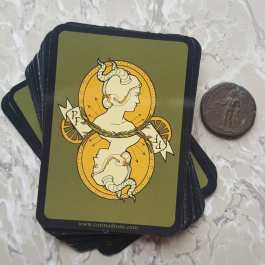
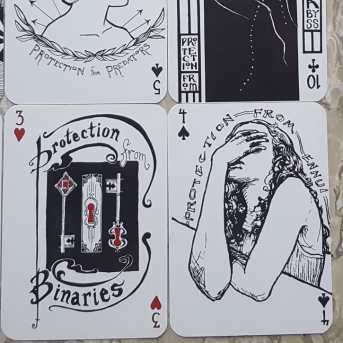
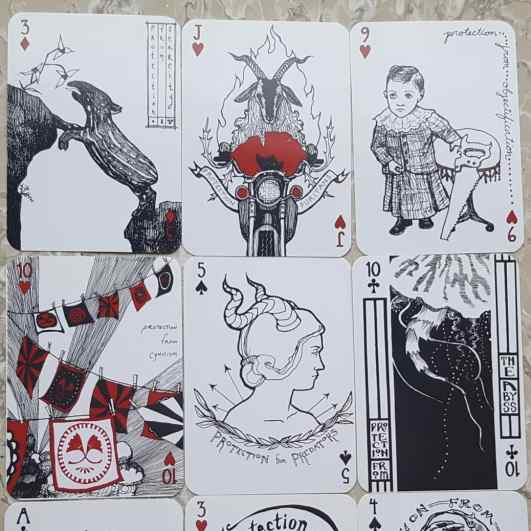
In a burst of good luck today, I also got a chance to talk to the heretofore astoundingly quiet interoffice mail delivery guy who startles me every other day with sudden envelopes over my shoulder when I am not paying attention. I discovered with perhaps slightly-too-unbridled glee that he is a kindred spirit as suspected, and a friendly conversationalist once the barrier is broken. He is leaving me to go to grad school for library sciences (twin!), and I even worked up the nerve to ask him about his work back in the day on Mystery Science Theater 3000, that tremendously strange staple of my youth. Hooray for wholly innocuous office crush!
May the fortitude be with you!
Love,
arrow
Mourners
06 Mar 2011 Leave a comment
in aural arts, heart branches, history, pondering arrow, visual arts
I recently visited an art museum exhibit on the mourning statues from the court of the Duke of Burgundy, and I was moved by their visual representation of the leveling power of grief. At the funeral for the Duke in 1419, black robes were handed out among the attendees to be worn over their clothes, concealing all symbols of rank and status, and uniting clergy, nobility, and the poor into one class for a fleeting moment. All were equally powerless under death.
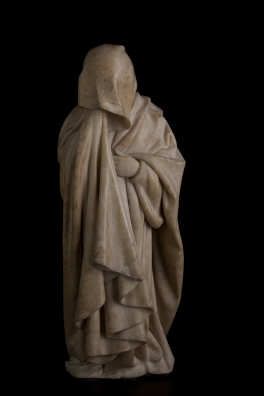
A local choir ensemble prepared a special concert of medieval music in conjunction with the Mourners exhibition, and you can listen to or download the songs by clicking on the picture above and scrolling to the bottom of the page. The recordings are haunting and beautiful.
I also recently made an emotional discovery while rifling through an old file of family history archives. My immediate family uses the nickname “Addie” for me. I had known since I was younger that this was the name of an ancestor who had died at a young age of typhoid during the family’s westward movement in a covered wagon from Ohio. By chance last week, I stumbled across her obituary, which I had never before read or even known to exist. Although written in an age where infant mortality rates were over 20% in America, and death on the plains was an everyday occurrence that could not interrupt the daily necessities of hard labor required to survive, this passage is written with more depth and eloquence than I have ever seen in an obituary in my time.
Friday, September 16, 1892
Gray County KansasMiss Addie M_, aged 15 years and three months, daughter of Mr. and Mrs. D. M_, died at the family residence last Monday after a very brief illness, and was buried in the Cimarron Cemetery Tuesday afternoon. It is said that “the remorseless past stands ever near, breathing through the broken cords of life its never-ending dirge.” Death invades every home, and “life after life flowers out from the darkness but to sink back into it again.” And so Death’s silent and remorseless step trod the precincts of David M_’s home and with his icy fingers sundered the cord that bound their darling to earth and set her spirit wending its way into eternity, shocking friends and making desolate the hearts of relatives – the more cruel, apparently, because of her youth, as she had just fairly started up life’s incline, at the summit seemingly such beautiful consummations awaiting her grasp. Death met and claimed her, but remorseless as death is, and possessing power to kill, he cannot extinguish the light of a correct life left behind. The sympathy of the entire community is extended to the bereaved parents.
To this article was appended the following:
October 14, 1892
As we go to press, it is reported that David M_, who has been sick for several days past, is dying. A daughter was buried a short time ago, and two other children are sick.
October 21, 1892
David M_, of whom mention was made in these columns last week died about 3 o’clock Monday morning of typhoid fever.
My great-great grandfather died at age 38, only one month after the death of his daughter Addie, leaving his grieving wife Mary alone in a sod house on 160 acres of plains, a widow with six surviving children, including one 18-month old baby (born en route as they crossed Illinois) and a seventh child on the way — my great-great aunt Clara, who would be born six months after her father’s death.
Addie and her father David were buried at a fork in the Santa Fe Trail in Kansas in an unmarked grave for 98 years, until 1990, when my relatives pooled their money to erect a gravestone at the site. Mary left Kansas shortly after the death of her child and husband, moving her brood of seven another 500 miles alone.
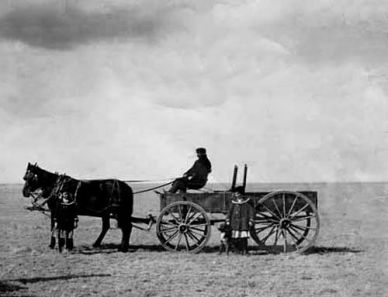
Although the typical season for this is autumn, I am taking some time this week to honor the memory of all those who have gone before, buried in plains and forests and along mountains and rivers, in this country and overseas.
Rest in peace, beloved family. Your final resting place may not be known, but you have not been forgotten.
Love,
arrow


